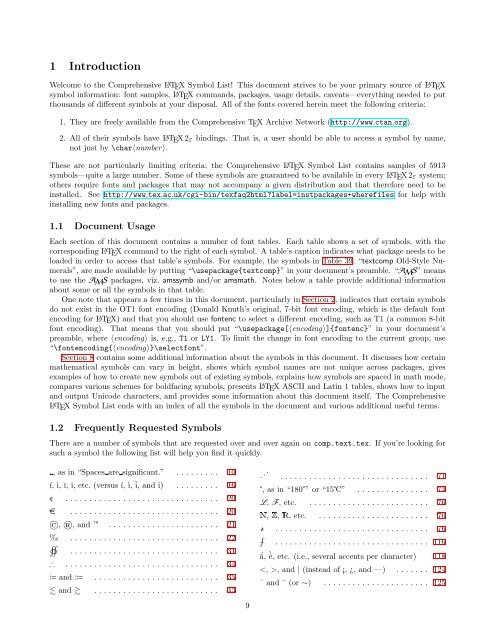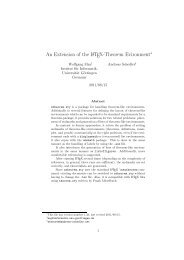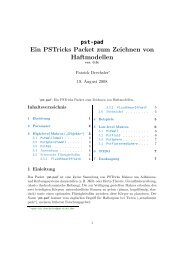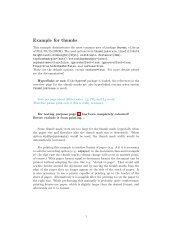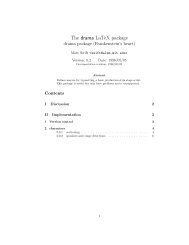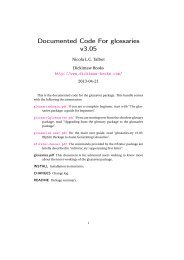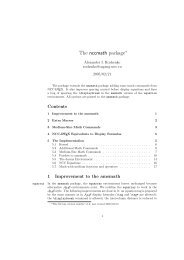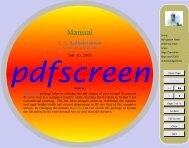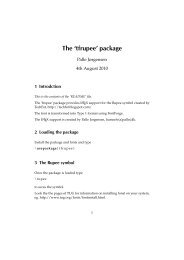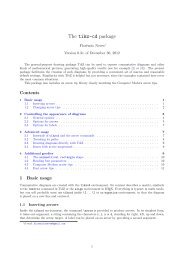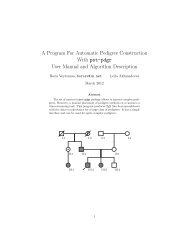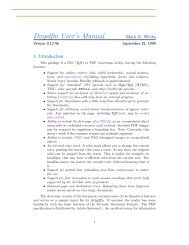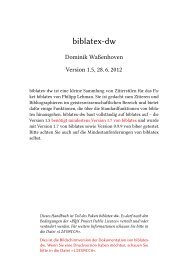The Comprehensive LaTeX Symbol List - CTAN
The Comprehensive LaTeX Symbol List - CTAN
The Comprehensive LaTeX Symbol List - CTAN
Create successful ePaper yourself
Turn your PDF publications into a flip-book with our unique Google optimized e-Paper software.
1 Introduction<br />
Welcome to the <strong>Comprehensive</strong> L ATEX <strong>Symbol</strong> <strong>List</strong>! This document strives to be your primary source of L ATEX<br />
symbol information: font samples, L ATEX commands, packages, usage details, caveats—everything needed to put<br />
thousands of different symbols at your disposal. All of the fonts covered herein meet the following criteria:<br />
1. <strong>The</strong>y are freely available from the <strong>Comprehensive</strong> TEX Archive Network (http://www.ctan.org).<br />
2. All of their symbols have L ATEX 2ε bindings. That is, a user should be able to access a symbol by name,<br />
not just by \char〈number〉.<br />
<strong>The</strong>se are not particularly limiting criteria; the <strong>Comprehensive</strong> L ATEX <strong>Symbol</strong> <strong>List</strong> contains samples of 5913<br />
symbols—quite a large number. Some of these symbols are guaranteed to be available in every L ATEX 2ε system;<br />
others require fonts and packages that may not accompany a given distribution and that therefore need to be<br />
installed. See http://www.tex.ac.uk/cgi-bin/texfaq2html?label=instpackages+wherefiles for help with<br />
installing new fonts and packages.<br />
1.1 Document Usage<br />
Each section of this document contains a number of font tables. Each table shows a set of symbols, with the<br />
corresponding L ATEX command to the right of each symbol. A table’s caption indicates what package needs to be<br />
loaded in order to access that table’s symbols. For example, the symbols in Table 39, “textcomp Old-Style Numerals”,<br />
are made available by putting “\usepackage{textcomp}” in your document’s preamble. “AMS” means<br />
to use the AMS packages, viz. amssymb and/or amsmath. Notes below a table provide additional information<br />
about some or all the symbols in that table.<br />
One note that appears a few times in this document, particularly in Section 2, indicates that certain symbols<br />
do not exist in the OT1 font encoding (Donald Knuth’s original, 7-bit font encoding, which is the default font<br />
encoding for L ATEX) and that you should use fontenc to select a different encoding, such as T1 (a common 8-bit<br />
font encoding). That means that you should put “\usepackage[〈encoding〉]{fontenc}” in your document’s<br />
preamble, where 〈encoding〉 is, e.g., T1 or LY1. To limit the change in font encoding to the current group, use<br />
“\fontencoding{〈encoding〉}\selectfont”.<br />
Section 8 contains some additional information about the symbols in this document. It discusses how certain<br />
mathematical symbols can vary in height, shows which symbol names are not unique across packages, gives<br />
examples of how to create new symbols out of existing symbols, explains how symbols are spaced in math mode,<br />
compares various schemes for boldfacing symbols, presents L ATEX ASCII and Latin 1 tables, shows how to input<br />
and output Unicode characters, and provides some information about this document itself. <strong>The</strong> <strong>Comprehensive</strong><br />
L ATEX <strong>Symbol</strong> <strong>List</strong> ends with an index of all the symbols in the document and various additional useful terms.<br />
1.2 Frequently Requested <strong>Symbol</strong>s<br />
<strong>The</strong>re are a number of symbols that are requested over and over again on comp.text.tex. If you’re looking for<br />
such a symbol the following list will help you find it quickly.<br />
, as in “Spaces are significant.” . . . . . . . . . 10<br />
í, ì, ī, î, etc. (versus í, ì, ī, and î) . . . . . . . . . 16<br />
¢ . . . . . . . . . . . . . . . . . . . . . . . . . . . . . . . . 20<br />
e . . . . . . . . . . . . . . . . . . . . . . . . . . . . . . . 20<br />
©, ®, and . . . . . . . . . . . . . . . . . . . . . . . 21<br />
‰ . . . . . . . . . . . . . . . . . . . . . . . . . . . . . . . 22<br />
<br />
. . . . . . . . . . . . . . . . . . . . . . . . . . . . . . . 31<br />
∴ . . . . . . . . . . . . . . . . . . . . . . . . . . . . . . . . 34<br />
≔ and . . . . . . . . . . . . . . . . . . . . . . . . . . 35<br />
and . . . . . . . . . . . . . . . . . . . . . . . . . . 43<br />
9<br />
. ..<br />
. . . . . . . . . . . . . . . . . . . . . . . . . . . . . . . 71<br />
°, as in “180°” or “15℃” . . . . . . . . . . . . . . . 74<br />
L, F, etc. . . . . . . . . . . . . . . . . . . . . . . . . . 76<br />
, , , etc. . . . . . . . . . . . . . . . . . . . . . . . 76<br />
r . . . . . . . . . . . . . . . . . . . . . . . . . . . . . . . . 76<br />
<br />
− . . . . . . . . . . . . . . . . . . . . . . . . . . . . . . . . 116<br />
´ā, ` ê, etc. (i.e., several accents per character) 118<br />
, and | (instead of ¡, ¿, and —) . . . . . . . 124<br />
ˆ and ˜ (or ∼) . . . . . . . . . . . . . . . . . . . . . . 125


